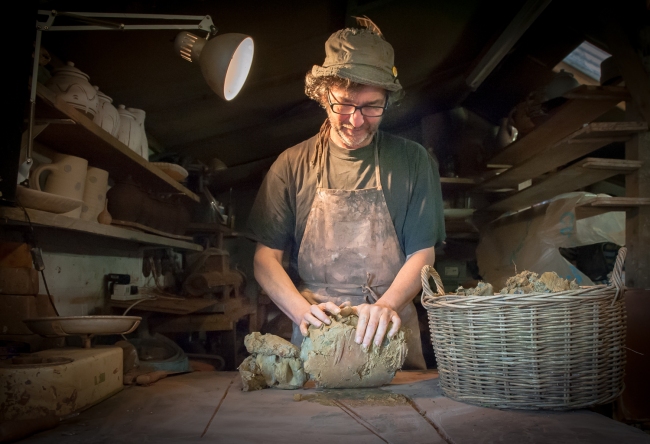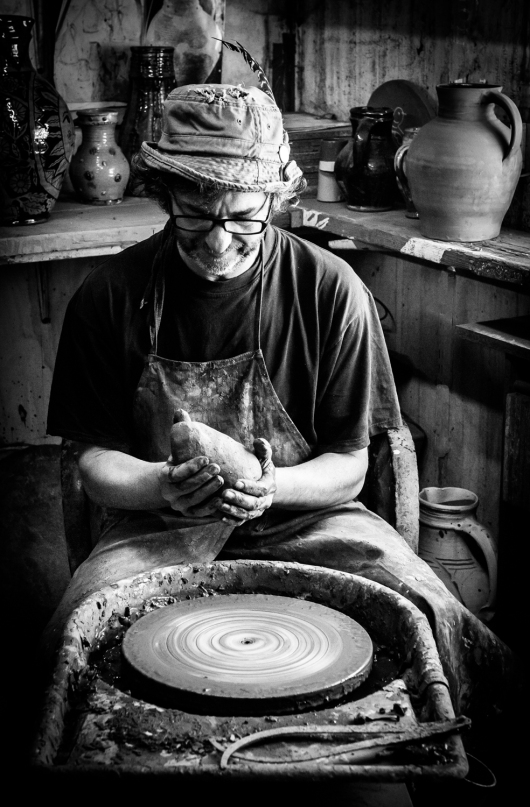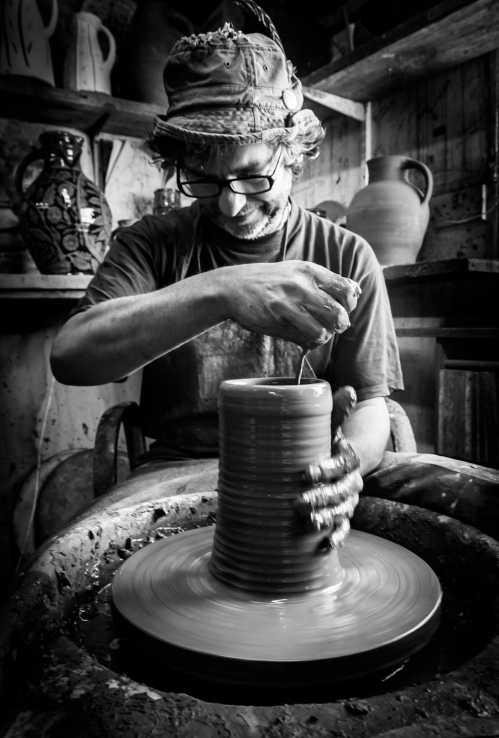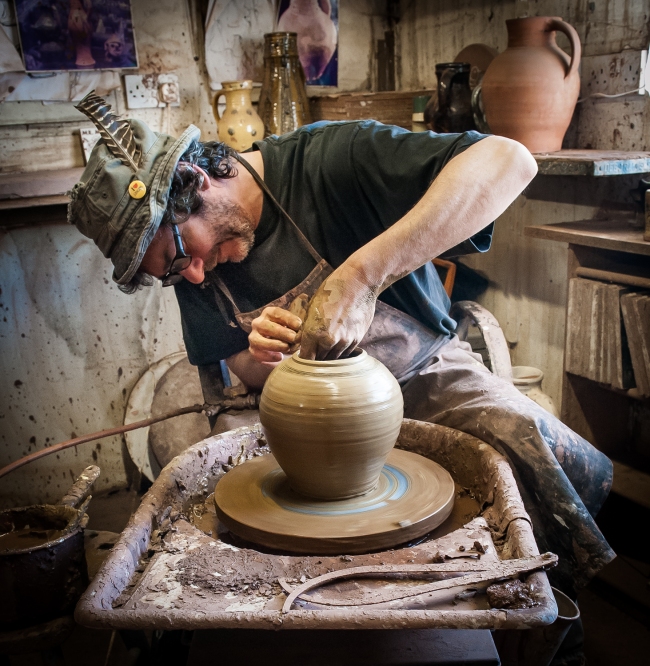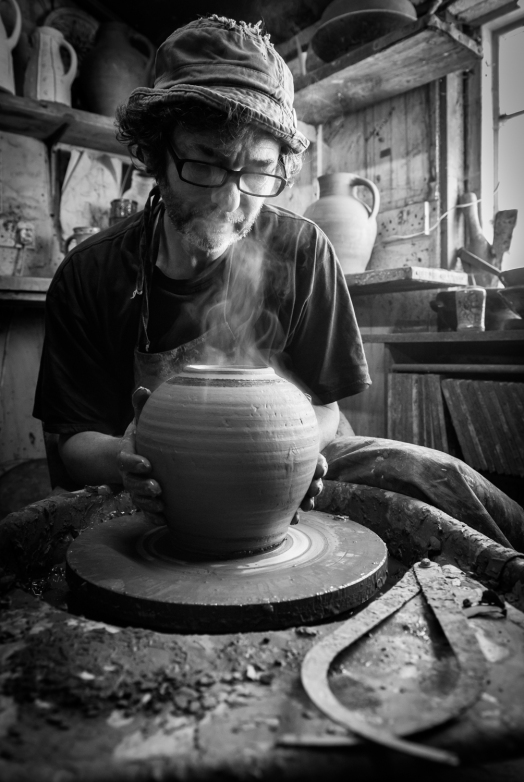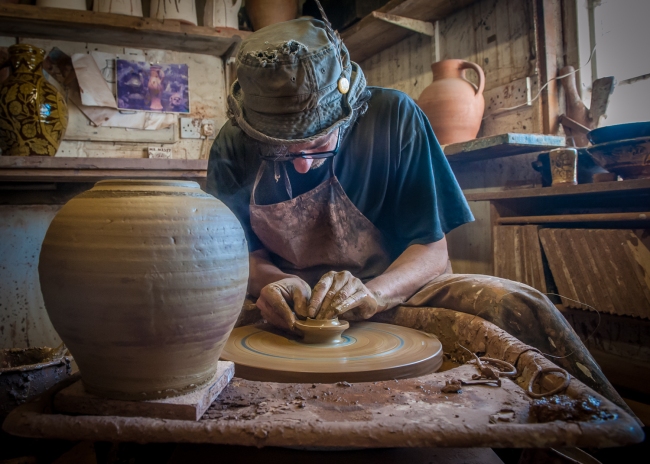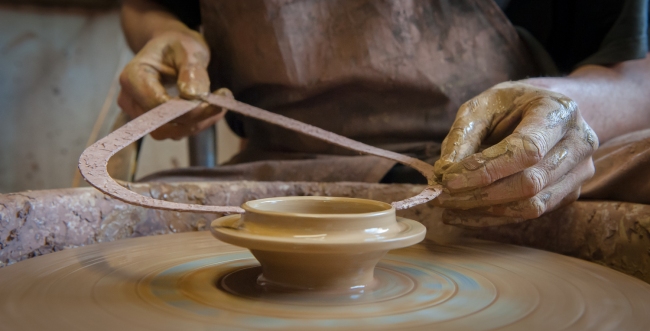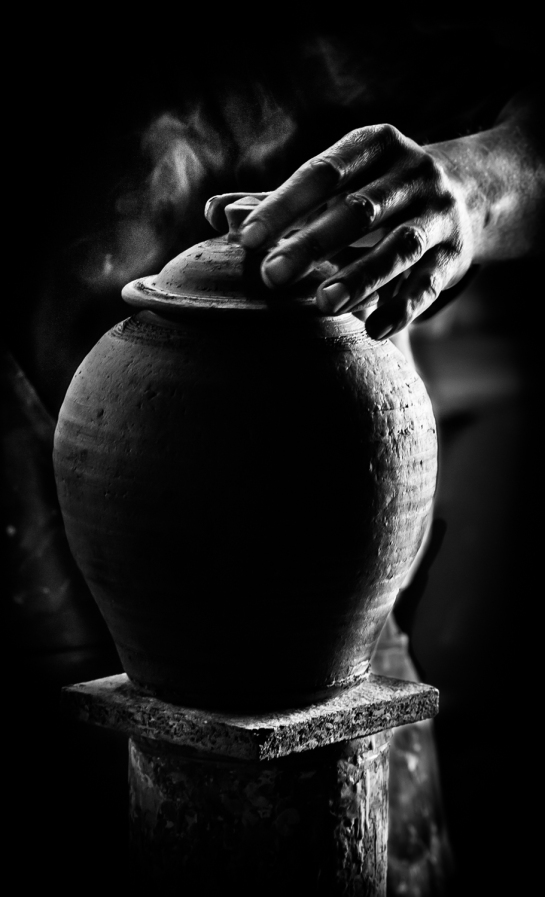CB/59
Preparing clay. This is where my job starts to get painfully difficult. The pottery is dark with mixed light sources. It is also cramped and somewhat cluttered. The opportunity to use any additional photographic lighting is scarce and I am about to start on my continued battle with balancing ISO, shutter speed and f stop to maintain enough DOF to have enough in focus, while making sure I don’t blur things out of recognition with a slow shutter speed. A wide-angled lens is often the only choice I have but whilst people who undertake portraiture might scoff at that, I think is enhances many of the images…. unless distortion is a personal bug-bear of yours of course! I have used the distorted lines of shelving to frame Douglas in this image and his desk light as an additional light source.
CB/60
“Twigs and leaves are removed before kneading the clay. Once blended, the clay ready for throwing.”
One of the rare times I had turned on some continuous light to bring out the texture of the clay. I remembered, whilst looking at assignment 4 reading in the book ‘Light Science and Magic’, that placing a light at approx. 45 degrees would bring out texture by enhancing shadow. Its not ideal as there are unfortunate shadows cast elsewhere but this is the nature of the beast. I am working in quick time here and there is no real time for stopping to consider the best lighting techniques. There isn’t room for reflectors.
CB/61
“After weighing, the clay is patted into shape. ”
Now the clay is ready to be thrown. There is darkness in the intensity of Douglas when he throws the clay and it’s why I have chosen to convert to black and white to help capture this. The ambient light from a window on camera right provides wonderful chiaroscuro. It’s a lighting technique that I love and have been influenced by Dutch oil painting portraiture such as any Rembrandt and also ‘A woman seated sewing’ by Johannes van der Aack over the years.It’s probably why I love the ‘noise’ from high ISO. I have discovered many artists love graininess in images and I think it come from their love of texture and materials.
CB/62
“Once placed on the wheelhead the intensity of concentration required is evident.”
Having said that I am okay with the high ISO above, it is the first time that I have been this brave with ISO but discovering a respectable DOF and shutter speed at this ISO did mean that I could expect to have both Douglas and the clay in focus with a little bit of luck. Using a DOF of less than that does mean that I have to make tough decisions. In the book a double page layout provides one mono conversion and 2 colour images (worth stating here as that element can’t be appreciated on this blog).
CB/63
There is only one chance with these images but when you get them right they look great. Keeping the hands tacks sharp and the motion in the spinning throws up some wonderful effect. Although a tripod is ideal, I find that I lose balance and trip over it so I go with ‘hand held’ approach for the most part. I’m quite certain this isn’t the best composition but, as I say, there is only one chance. I would have liked to have taken this image from the side and used his arm as a lead line but there just wasn’t the space.
CB/64
“With careful manipulation, the pot begins to emerge.”
Again, I am disappointed with the composition but the effect of the clay and the spinning I am pleased with.
CB/65
“Extra moisture is often required.”
Another problem with working alongside potter is that they never sit still and their limbs are always contorted and moving in and out of frame.
CB/66
“The shape of the piece is now forming.”
CB/67
“Douglas often uses a gas burner to speed up the process of drying.”
Both CB/66 & CB/67 shows another example of an awkwardly posed potter. However we can see the pot taking shape beautifully.
CB/68
“As the steam rises Douglas inspects the piece for any imperfections.”
With the steam rising into Douglas’s face and the callipers leading into the frame, this is one of my favourite from the set.
CB/69
Now that the pot is completed I have left it in the shot to introduce the lid being made. I have decided to drop the ISO as I can use a shallower depth of field to concentrate on the lid and hands.
CB/70
“The lid is made and callipers are used to ensure a good fit.”
The contrast in materials and texture coupled with repetition of curves makes for a pleasing image.
CB/71
Douglas is now just engaging with his surroundings again after an intense half an hour – a simple portrait.
CB/72
This image I am particularly pleased with. It is well balanced and everything is sharp whilst the wheel is in motion. I was able to ask Douglas to move his hand slightly to take the shadow away that was falling onto the tool.
CB/73
Also this image couldn’t have gone better. I managed to take the photograph at the point of ignition and the sparks are pushed forward and evident in the flame.
CB/74
I am thrilled to bits with this. Some might not appreciate the detached hand but the completed pot has the lid placed on top while it is still steaming. I applied an ambient silhouette light technique that I had explored briefly in assignment 4.
